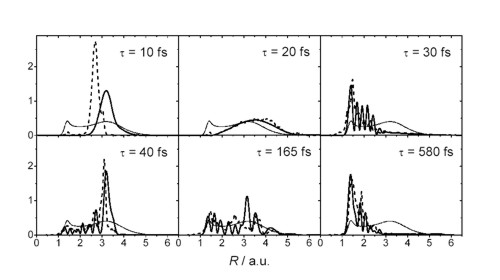Mapping of coherent nuclear wavepacket dynamics in
D2+ with ultrashort laser pulses
Bernold Feuerstein1,2, Uwe Thumm1
1James R. Macdonald Laboratory, Department of Physics, Kansas State University,
Manhattan, KS 66506-2604, USA
2Permanent Address: Max-Planck-Institut für Kernphysik, D-69029 Heidelberg, Germany
Fast ionization of D2 leads to the coherent
population of many vibrational states of
D2+.
Usually, only the squared absolute values of the
vibrational state amplitudes, known as Franck-
Condon factors, are observed since insufficient
experimental time resolution averages out all
coherence effects. We propose a Coulomb
explosion imaging method to visualize the coherent
motion of bound wavepackets using ultrashort (5 fs),
intense pump-probe laser pulses. With this type
of experiment, decoherence times in the fs to ps
range could be directly measured, providing
essential information for coherent control.
In order to simulate such a type of experiment,
we solve the time-dependent Schrodinger equation
in a 2D collinear model (along the laser
polarization axis) for D2+
with one dimension for
the electronic and the nuclear coordinate,
respectively. For the time propagation of the
wavepackets, we use the Crank-Nicholson splitoperator
technique. Momentum distributions are
derived using the "virtual detector" method [1].
We demonstrate the Coulomb explosion
imaging of both dissociating and bound nuclear
wavepackets. For dissociation, we consider the
v=0 ground state of D2+
interacting with two 25 fs
pulses of 0.3 PW/cm2 intensity and variable delay.
Our calculation reproduces qualitatively results of
a previous pump-probe experiment [2]. The
reconstructed bound wavepackets from a
simulation of a pump-probe study with D2 (v=0)
as initial state using intense ultrashort pulses are
shown in Figure 1.

Figure 1: Snapshots of the coherent nuclear motion in D2+ following
ionization of D2 (v=0) in a 5 fs, 1 PW/cm2 laser pulse for various delays
τ of the probe pulse. Solid curves: original density |Φ(R,τ)|2.
Dashed curves:
reconstructed probability density. The time-independent Franck-Condon
distribution is given by the dotted curve.
References:
[1] B. Feuerstein and U. Thumm, J. Phys. B 36, 707 (2003).
[2] C. Trump, H. Rottke, and W. Sandner, Phys. Rev. A 59, 2858 (1999).
This work was supported by the
Chemical Sciences, Geosciences and Biosciences Division,
Office of Basic Energy Sciences,
Office of Science,
U.S. Department of Energy.
B.F. acknowledges
the financial support in form of a Research
Scholarship from the Deutsche Forschungsgemeinschaft.
Submitted to ISIAC 2003, July 2003 in Stockholm, Sweden.
This abstract is also available in
Postscript or
Adobe Acrobat formats.
